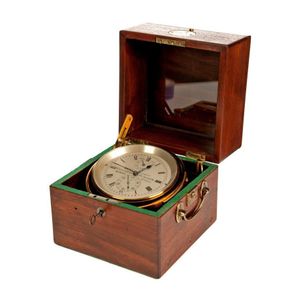J. Sewill Brass Deck Watch with Duplex Movement
You must be a subscriber, and be logged in to view price and dealer details.
Subscribe Now to view actual auction price for this item
When you subscribe, you have the option of setting the currency in which to display prices to $Au, $US, $NZ or Stg.
- Movement - The technical name for the workings of a clock or watch, and does not include the dial or case.
- Fusee - The fusee movement was used in clocks and pocket watches from the mid 17th century. The fusee is a cone shaped drum within the works that is linked to the barrel of the spring, usually by a length of chain.
As the mainspring loses its tension over time, the cone shaped barrel compensates for this by increasing the tension, by pulling the mainspring tighter, thus ensuring the time remains constant.
Use of the fusee in clocks was superseded by the "going barrel" in the mid 19th century and for pocket watches at the beginning of the 19th century.
The fusee continued to be used in marine chronometers until the 1970s. - Subsidiary Dial - On a clock or watch, a subsidiary dial, also called an auxiliary dial, is a dial that is secondary to the main dial and may show seconds, day of the week or month, or strike silent. A subsidiary dial may be within our outside the main dial, and a clock or watch may have several subsidiary dials.
This item has been included into following indexes:
Visually similar items

A fine 19th century two day marine Chronometer with Dent's patent staple balance and Ernshaw spring detent escapement, freesprung. The balance consists of a cross bar with U shaped bimetallic affixes to reduce the effects of temperature. Silvered dial with

An early English marine chronometer, C.1830, silvered and engraved dial marked 'French, Royal Exchange, London, No.5156' (i.e. Santiago James Moore French), signature and serial number boldly repeated on back plate, two-day duration with Arnold type spring

Chronometer by Thomas Mercer Ltd St. Albans, England, in original timber case. Supplied by Henry Browne & Son Ltd Barking (no. 19226), with Dutch shipping lable 'N.V. Observator Rotterdam' & vessel name (illegible)

A small early 20th century Waltham ships clock in three tier mahogany case. Up/down dials, blue steel hands.15 jewel keyless movement. Lever escapement. Heavy brass case and suspended in gimbal fittings. Height 15 cm. Length 15 cm. Depth 15 cm
